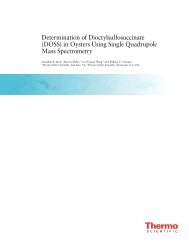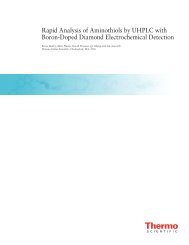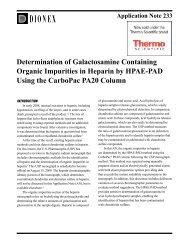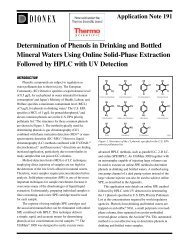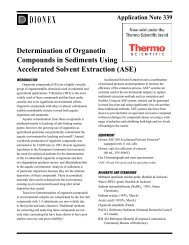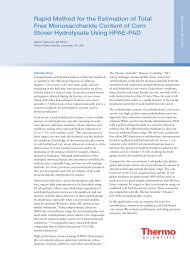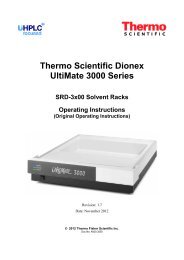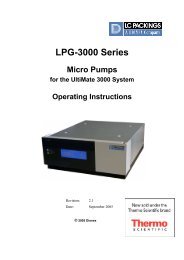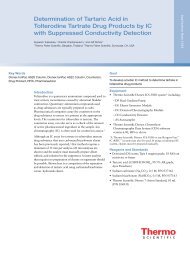Acclaim Polar Advantage (PA) HPLC Columns - Dionex
Acclaim Polar Advantage (PA) HPLC Columns - Dionex
Acclaim Polar Advantage (PA) HPLC Columns - Dionex
You also want an ePaper? Increase the reach of your titles
YUMPU automatically turns print PDFs into web optimized ePapers that Google loves.
columns<br />
<strong>Acclaim</strong> <strong>Polar</strong><strong>Advantage</strong> columns<br />
are reversed-phase silica columns with a<br />
polar-enhanced stationary phase for<br />
operation at wider chromatographic<br />
conditions and with a broader application<br />
range when compared to conventional<br />
reversed-phase columns.<br />
• Analysis of polar and nonpolar<br />
analytes<br />
• Excellent peak shapes for both basic<br />
and acidic analytes<br />
• Compatible with 100% aqueous<br />
mobile phases<br />
• High reversed-phase capacity<br />
• Unique polar selectivity<br />
• Mass spectrometry (MS) compatible<br />
<strong>Acclaim</strong> ® <strong>Polar</strong><strong>Advantage</strong> <strong>HPLC</strong> <strong>Columns</strong><br />
Separate Both <strong>Polar</strong> and Nonpolar<br />
Compounds<br />
<strong>Acclaim</strong> <strong>Polar</strong><strong>Advantage</strong> (<strong>PA</strong>)<br />
columns are a new line of silica-based,<br />
reversed-phase columns featuring a<br />
polar-enhanced stationary phase. This<br />
phase consists of a C16 functional group<br />
bonded to the surface of ultrapure silica<br />
using a sulfonamide group, coupled to an<br />
ether linkage (Figure 1). While providing<br />
polarity, hydrophobicity, and selectivity<br />
similar to conventional C18 phases, this<br />
CH 3<br />
O Si (CH2) 3 O N S<br />
CH 3<br />
Figure 1. <strong>Acclaim</strong> <strong>Polar</strong><strong>Advantage</strong> bonding.<br />
new polar-embedded phase provides<br />
excellent peak shapes for both basic and<br />
acidic compounds, compatibility with<br />
100% aqueous mobile phases, and<br />
hydrolytic stability—overcoming many of<br />
the limitations of conventional C8 and<br />
C18 reversed-phase columns.<br />
<strong>Acclaim</strong> <strong>PA</strong> columns exhibit<br />
enhanced retention of polar compounds<br />
and the ability to perform analysis of both<br />
polar and nonpolar analytes on a single<br />
column. By providing for a much larger<br />
range of application<br />
possibilities,<br />
the <strong>Acclaim</strong> <strong>PA</strong><br />
O<br />
column can meet<br />
(CH2) 15CH or exceed the<br />
3<br />
requirements for<br />
O<br />
the majority of<br />
reversed-phase<br />
<strong>HPLC</strong> separations.<br />
CH 3<br />
19297
Wide Range of Applications<br />
For conventional reversed-phase<br />
separations, the <strong>Acclaim</strong> <strong>PA</strong> column<br />
exhibits selectivities similar to standard<br />
C8 or C18 phases. As illustrated in<br />
Figures 2–9, <strong>Acclaim</strong> <strong>PA</strong> can be used in a<br />
wider range of application areas,<br />
including pharmaceuticals, bio and life<br />
sciences, foods, and environmental<br />
analysis work. In addition, Figures 2–3<br />
show that efficient separations with good<br />
peak shapes are obtained for compounds<br />
of life science (nucleic acid bases) and<br />
pharmaceutical interest (sulfonamides),<br />
using highly aqueous mobile phases.<br />
200<br />
mAU<br />
0<br />
1<br />
0 1 2 3 4<br />
Minutes<br />
5 6 7 8<br />
Figure 2. Separation of nucleic acid bases.<br />
180<br />
mAU<br />
0<br />
1<br />
Figure 3. Separation of sulfa drugs.<br />
2<br />
3<br />
3 4<br />
5<br />
0 1 2 3 4 5 6 7 8 9 10 11 12 13<br />
Minutes<br />
4<br />
6<br />
5<br />
7<br />
8<br />
Column: <strong>Acclaim</strong> <strong>PA</strong>, 5 µm<br />
Dimensions: 150 × 4.6 mm<br />
Mobile phase: 30 mM phosphate, pH 3.5<br />
Temperature: 30 °C<br />
Flow rate: 1 mL/min<br />
Injection vol: 5 µL<br />
Detection: UV, 254 nm<br />
Peaks: 1. Cytosine 50 µg/mL<br />
2. Uracil 50<br />
3. Adenine 50<br />
4. Guanine 50<br />
5. Thymine 100<br />
Column: <strong>Acclaim</strong> <strong>PA</strong>, 3 µm<br />
Temperature: 30 °C<br />
Dimensions: 150 x 4.6 mm<br />
Flow rate: 1 mL/min<br />
Mobile phase: (A) 90/10 v/v MeOH/20 mM Injection vol: 10 µL<br />
phosphate, pH 2.7<br />
Detection: UV, 254 nm<br />
(B) 10/90 v/v MeOH/20 mM<br />
phosphate, pH 2.7<br />
Peaks: 1. Sulfanilic acid<br />
2. Sulfanilamide<br />
6 µg/mL<br />
4<br />
Gradient: 15–30% A at 5 min,<br />
3. Sulfadiazine 10<br />
2<br />
to 75% at 10 min, to 85% at 12 min<br />
4. Sulfathiazole<br />
5. Sulfamerazine<br />
10<br />
10<br />
6. Sulfamethazine 10<br />
7. Sulfamethoxazole 14<br />
9<br />
8. Sulfisoxazole<br />
9. Sulfadimethoxine<br />
12<br />
18<br />
350<br />
Column: <strong>Acclaim</strong> <strong>PA</strong>, 5 µm<br />
2<br />
Dimensions: 150 × 4.6 mm<br />
Mobile phase: 80/20 v/v MeOH/<br />
30 mM phosphate, pH 6.0<br />
mAU<br />
3<br />
4<br />
6<br />
Temperature:<br />
Flow rate:<br />
30 °C<br />
1 mL/min<br />
1<br />
5<br />
Injection vol:<br />
Detection:<br />
5 µL<br />
UV, 220 nm<br />
Peaks: 1. Uracil 10 µg/mL<br />
2. Protriptyline 50<br />
3. Nortriptyline 25<br />
0<br />
4. Doxepin 50<br />
5. Imipramine 40<br />
0 1 2 3 4<br />
Minutes<br />
5 6 7 8 6. Amitriptyline 50<br />
Figure 4. Separation of antidepressants.<br />
19298<br />
19300<br />
19299
350<br />
1<br />
2<br />
Column:<br />
Dimensions:<br />
<strong>Acclaim</strong> <strong>PA</strong>, 5 µm<br />
150 × 4.6 mm<br />
3<br />
Mobile phase: 60/40 v/v CH CN/D.I. H O<br />
3 2<br />
4 Temperature: 30 °C<br />
mAU<br />
Flow rate: 1 mL/min<br />
Injection vol: 2 µL<br />
Detection: UV, 254 nm<br />
Peaks: 1. Methylparaben 250 µg/mL<br />
2. Ethylparaben 250<br />
0<br />
3. Propylparaben<br />
4. Butylparaben<br />
250<br />
250<br />
0 1 2<br />
3 4 5<br />
Minutes<br />
Figure 5. Separation of parabens.<br />
200<br />
mAU<br />
0<br />
Figure 6. Separation of fat-soluble vitamins A, D 2 , D 3 , and E.<br />
350<br />
mAU<br />
0<br />
1<br />
Column: <strong>Acclaim</strong> <strong>PA</strong>, 3 µm<br />
Detection: UV, 210 nm<br />
Dimensions: 150 × 4.6 mm<br />
Peaks: 1. Thiamine HCI 20 µg/mL<br />
Mobile phase: (A) CH CN 3<br />
(B) 25 mM KH PO , pH 3.5<br />
2 4<br />
2. Nicotinic acid<br />
3. Pyridoxine<br />
4. Niacinamide<br />
20<br />
20<br />
20<br />
Temperature: 30 °C<br />
5. Pantothenic acid 20<br />
Gradient:<br />
Flow rate:<br />
0–20% A at 15 min, 60% A at 17–20 min<br />
1 mL/min<br />
6. Folic acid<br />
7. Vitamin B12<br />
8. Biotin<br />
20<br />
20<br />
20<br />
Injection vol. 5 µL<br />
9. Riboflavin 20<br />
2<br />
0 2 4 6<br />
1<br />
0 2 4 6<br />
Minutes<br />
8 10<br />
3<br />
Minutes<br />
Figure 7. Separation of water-soluble vitamins.<br />
4<br />
5<br />
2<br />
3<br />
6 7<br />
8 10 12 14<br />
8<br />
9<br />
16<br />
19301<br />
Column: <strong>Acclaim</strong> <strong>PA</strong>, 5 µm<br />
Dimensions: 150 × 4.6 mm<br />
Mobile phase: 97/3 v/v CH CN/D.I. H O<br />
2 2<br />
Temperature: 30 °C<br />
Flow rate: 1 mL/min<br />
Injection vol: 10 µL<br />
Detection: UV, 264 nm<br />
Peaks: 1. All-trans Retinol (Vitamin A) 120 µg/mL<br />
4<br />
2. Ergocalciferol (Vitamin D ) 120<br />
2<br />
3. Cholecalciferol (Vitamin D ) 60<br />
3<br />
4. α-Tocopherol (Vitamin E) 1300<br />
12<br />
19302<br />
19303<br />
Separate <strong>Polar</strong> and Nonpolar Analytes<br />
on a Single Column<br />
Separation of antidepressants (Figure<br />
4), nonpolar parabens (Figure 5), and fatsoluble<br />
vitamins (Figure 6) represent more<br />
conventional reversed-phase separations,<br />
whereas the addition of water-soluble<br />
vitamins (Figure 7) illustrates the versatility<br />
of this unique column.
350<br />
mAU<br />
0<br />
0<br />
Column: <strong>Acclaim</strong> <strong>PA</strong>, 3 µm<br />
Dimensions: 150 × 4.6 mm<br />
Mobile phase: (A) 2.5 mM MSA* in MeOH<br />
(B) 2.5 mM MSA in D.I. H O 2<br />
Gradient: Hold A/B (60:40) for 4.5 min,<br />
A/B (60:40) to A/B (95:5) in 6 min,<br />
Hold A/B (95:5) for 7.5 min<br />
Temperature: 25 °C<br />
Flow rate: 1 mL/min<br />
9<br />
Injection vol. 5 µL<br />
Detection: UV, 285 nm<br />
1 2<br />
3<br />
4 5<br />
2 4 6 8 10 12 14<br />
6<br />
7<br />
Minutes<br />
Figure 8. Separation of phenols (E<strong>PA</strong> 604 method mix).<br />
70<br />
mAU<br />
0<br />
0<br />
Column: <strong>Acclaim</strong> <strong>PA</strong> 5 µm<br />
Dimensions: 250 × 4.6 mm<br />
Mobile phase: (A) CH CN 3<br />
(B) D.I. H O 2<br />
Gradient: Hold A/B (50:50) for 5 min,<br />
A/B (50:50) to A/B (85:15) in 35 min,<br />
Hold A/B (85:15) for 5 min<br />
Temperature: 25 °C<br />
Flow rate: 2 mL/min<br />
6<br />
Injection vol. 10 µL<br />
Detection: UV, 254 nm<br />
1<br />
2<br />
3<br />
4<br />
5<br />
7<br />
8<br />
5 10 15 20 25 30 35<br />
Minutes<br />
8<br />
10<br />
9<br />
10<br />
11<br />
12<br />
11<br />
Peaks: 1. Phenol<br />
2. 2-Chlorophenol<br />
3. 4-Nitrophenol<br />
4. 2-Nitrophenol<br />
5. 2,4-Dimethylphenol<br />
6. 4-Chloro-3-methylphenol<br />
7. 2,4-Dichlorophenol<br />
8. 2,4-Dinitrophenol<br />
9. 2-Methyl-4,6-dichlorophenol<br />
10. 2,4,6-Trichlorophenol<br />
11. Pentachlorophenol<br />
13<br />
40<br />
16<br />
15<br />
16<br />
14<br />
*Methanesulfonic acid<br />
45<br />
18<br />
Peaks: 1. Naphthalene<br />
2. Acenaphthylene<br />
3. Acenaphthene<br />
4. Fluorene<br />
5. Phenanthrene<br />
6. Anthracene<br />
7. Fluoranthene<br />
8. Pyrene<br />
9. Benzo[a] anthracene<br />
10. Chrysene<br />
11. Benzo[b] fluoranthene<br />
12. Benzo[k] fluoranthene<br />
13. Benzo[a] pyrene<br />
14. Dibenz[a,h] anthracene<br />
15. Benzo[g,h,i] perylene<br />
16. Indeno[1,2,3-cd] pyrene<br />
Figure 9. Separation of <strong>PA</strong>H polyaromatic hydrocarbons (E<strong>PA</strong> 610 method mix).<br />
19304<br />
19305<br />
Versatile Operating Conditions<br />
Standard environmental applications<br />
can also be performed (Figures 8<br />
and 9) without significant changes to<br />
analyte elution order, when compared to<br />
conventional C18 phases.<br />
The range of chromatographic<br />
conditions that can be used with <strong>Acclaim</strong><br />
<strong>PA</strong>, combined with the wide polarity<br />
range of target analytes, has resulted in<br />
an extremely versatile column that can<br />
be used for method development,<br />
problem solving, and other analytical<br />
areas where conventional reversed-phase<br />
columns have limitations.
Resistant to Dewetting<br />
Because of their high solubility,<br />
many polar analytes are adequately<br />
retained on a reversed-phase column<br />
only when the organic content of the<br />
eluent is very low (
AU<br />
Figure 12. Low silanol activity.<br />
AU<br />
1.5 1.6 1.7 1.8 1.9 2.0 2.1 2.2 2.3 2.4<br />
Minutes<br />
Discovery Amide RP C16<br />
1 2<br />
3<br />
Symmetry Shield C18<br />
1<br />
2<br />
3<br />
<strong>Acclaim</strong> <strong>Polar</strong><strong>Advantage</strong><br />
1 2<br />
3 4<br />
Luna C18<br />
Discovery RP - Amide C16<br />
Asymmetry = 0.95<br />
Waters Symmetry Shield C18<br />
Asymmetry = 2.36<br />
1 2<br />
4<br />
0 1 2 3 4 5 6 7<br />
Minutes<br />
4<br />
6<br />
3 4<br />
Figure 13. Comparison of selectivity.<br />
AU<br />
<strong>Acclaim</strong> <strong>Polar</strong><strong>Advantage</strong><br />
Asymmetry = 1.39<br />
5<br />
Conventional C18<br />
Asymmetry = 3.47<br />
0 2 4 6<br />
Minutes<br />
8 10 12<br />
Peaks:<br />
1<br />
1<br />
2, 3<br />
1<br />
1<br />
4<br />
2 3<br />
2<br />
3 4<br />
Figure 14. Comparison of steric selectivity.<br />
2<br />
3<br />
4<br />
5<br />
Luna C18<br />
5<br />
6<br />
Agilent Bonus RP<br />
5, 6<br />
Symmetry Shield C18<br />
<strong>Acclaim</strong> <strong>Polar</strong><strong>Advantage</strong><br />
1. Toluene 2. Phenanthrene 3. o–Terphenyl 4. Triphenylene<br />
Me<br />
6<br />
4<br />
Column: 5 µm<br />
Dimensions: 150 × 4.6 mm<br />
Eluent: 50/50 v/v CH CN/D.I. H O<br />
3 2<br />
Temperature: 30 °C<br />
Flow rate: 1.0 mL/min<br />
Injection vol: 5 µL<br />
Detection: UV, 226 nm<br />
Analyte: Pyridine<br />
Concentration: 85 µg/mL<br />
Column: 5 µm<br />
Dimensions: 150 × 4.6 mm<br />
Mobile phase: 40/60 v/v 50 mM phosphate<br />
pH 3.2/CH CN 3<br />
Temperature: 30 °C<br />
Flow rate: 1.0 mL/min<br />
Injection vol: 5 µL<br />
Detection: UV, 254 nm<br />
Peaks: 1. Uracil<br />
2. Pyridine<br />
3. Phenol<br />
4. N,N–Dimethylaniline<br />
5.n–Bu-benzoic acid<br />
6. Toluene<br />
Column: 5 µm<br />
Dimesnions: 150 × 4.6 mm<br />
Mobile phase: 90/10 v/v MeOH/D.I. H O 2<br />
Temperature: 30 °C<br />
Flow rate: 1.0 mL/min<br />
Injection vol: 5 µL<br />
Detection: UV, 254 nm<br />
19307<br />
19308<br />
19309<br />
Improved Peak Shape<br />
Interaction with residual silanol<br />
groups on the surface of the silica<br />
particle can result in peak tailing, which<br />
can affect peak resolution and integration.<br />
This effect can be reduced by<br />
optimizing the surface coverage of the<br />
bonded phase, exhaustive end-capping of<br />
the residual silanol groups, and minimization<br />
of metal contaminants that<br />
increase the acidity of the free silanol<br />
groups. The tailing of pyridine is a very<br />
good indicator of the number of exposed<br />
silanol groups on the silica surfaces.<br />
Figure 12 compares the performance of<br />
<strong>Acclaim</strong> <strong>PA</strong> with leading competitive<br />
columns for pyridine peak asymmetry.<br />
Exhaustive end-capping of <strong>Acclaim</strong> <strong>PA</strong><br />
phases, combined with the embedded<br />
polar functional group, provide improved<br />
peak shapes for both basic and acidic<br />
analytes at low- and mid-range pH<br />
values (Figure 13). Figure 13 also<br />
illustrates that while providing a much<br />
broader range of application possibilities,<br />
the <strong>Acclaim</strong> <strong>PA</strong> column maintains<br />
selectivities very similar to conventional<br />
C18 phases when compared to other<br />
polar-embedded column types.<br />
Enhanced Steric Selectivity and<br />
Resolution<br />
<strong>Acclaim</strong> <strong>PA</strong> can provide enhanced<br />
resolution of closely related compounds,<br />
resulting in additional ability to improve<br />
separations, compared to conventional<br />
reversed-phases and other types of polarembedded<br />
phases (Figure 14). This<br />
ability can be very beneficial when<br />
analyzing very complex mixtures,<br />
resolving closely eluting compounds, or<br />
detecting low-level contaminants.
Reproducible Manufacturing<br />
To meet the exacting needs of our<br />
customers, each <strong>Acclaim</strong> <strong>PA</strong> column is<br />
manufactured to stringent specifications to<br />
ensure column-to-column reproducibility<br />
and reliability. Each column is shipped<br />
with a lot validation showing the test<br />
results and specifications for the lot of<br />
bonded silica packed into the column, and<br />
an individual test chromatogram validating<br />
performance.<br />
Phase:<br />
C16<br />
Particle Size:<br />
3 and 5 µm<br />
Pore Size:<br />
120 Å<br />
ACCLAIM <strong>PA</strong><br />
SPECIFICATIONS<br />
Surface Area:<br />
300 m2 /g<br />
Carbon load:<br />
16–18%<br />
pH Range:<br />
2–8<br />
ORDER INFORMATION<br />
To order in the U.S., call (800) 346-6390 or contact the <strong>Dionex</strong> Regional Office<br />
nearest you. Outside the U.S., order through your local <strong>Dionex</strong> office or distributor.<br />
Refer to the following part numbers.<br />
<strong>Acclaim</strong> <strong>PA</strong>, 3 µm analytical (2.1 × 100 mm) ............................................... 061316<br />
<strong>Acclaim</strong> <strong>PA</strong>, 3 µm analytical (2.1 × 150 mm) ............................................... 061317<br />
<strong>Acclaim</strong> <strong>PA</strong>, 3 µm analytical (4.6 × 150 mm) ............................................... 061318<br />
<strong>Acclaim</strong> <strong>PA</strong>, 5 µm analytical (4.6 × 50 mm) ................................................. 061319<br />
<strong>Acclaim</strong> <strong>PA</strong>, 5 µm analytical (4.6 × 150 mm) ............................................... 061320<br />
<strong>Acclaim</strong> <strong>PA</strong>, 5 µm analytical (4.6 × 250 mm) ............................................... 061321<br />
<strong>Acclaim</strong> <strong>PA</strong>, 5 µm Guard Cartridges (2 × 10 mm),<br />
2 each ...................................................................................................... 061331<br />
<strong>Acclaim</strong> <strong>PA</strong>, 5 µm Guard Cartridges (4.3 × 10 mm),<br />
2 each ...................................................................................................... 061332<br />
<strong>Acclaim</strong> Guard Kit (Holder and Coupler) ..................................................... 059526<br />
<strong>Acclaim</strong> SST Guard Cartridge Holder .......................................................... 059456<br />
Guard to Analytical Column Coupler ............................................................ 059457
<strong>Acclaim</strong> is a registered trademark of <strong>Dionex</strong> Corporation.<br />
Printed on recycled and recyclable paper.<br />
<strong>Dionex</strong> Corporation <strong>Dionex</strong> Corporation <strong>Dionex</strong> U.S. Regional Offices <strong>Dionex</strong> International Subsidiaries<br />
1228 Titan Way Salt Lake City Technical Center Sunnyvale, CA (408) 737-8522 Austria (01) 616 51 25 Belgium (03) 353 42 94 Canada (905) 844-9650 China (852) 2428 3282 Denmark 36 36 90 90<br />
P.O. Box 3603 1515 West 2200 South, Suite A Westmont, IL (630) 789-3660 France 01 39 30 01 10 Germany 06126-991-0 Italy (06) 66 51 50 52 Japan (06) 6885-1213 The Netherlands (0161) 43 43 03<br />
Sunnyvale, CA Salt Lake City, UT Houston, TX (281) 847-5652 Switzerland (062) 205 99 66 United Kingdom (01276) 691722<br />
94088-3603 84119-1484 Atlanta, GA (770) 432-8100 * Designed, developed, and manufactured under an NSAI registered ISO 9001 Quality System.<br />
(408) 737-0700 (801) 972-9292 Marlton, NJ (856) 596-0600 LPN 1533 8M 05/03<br />
© 2003 <strong>Dionex</strong> Corporation




